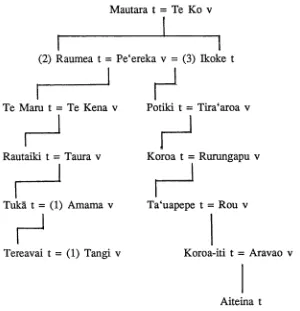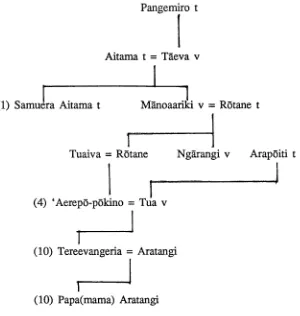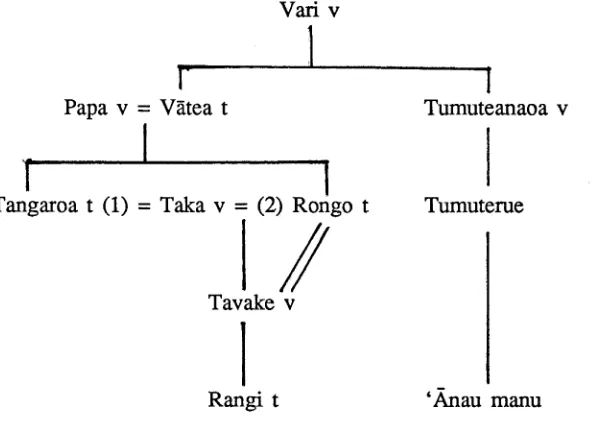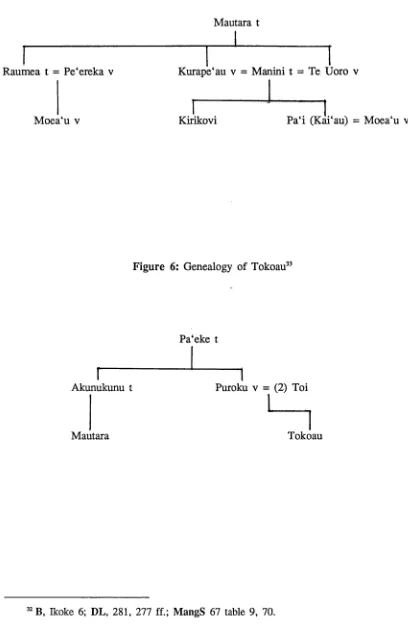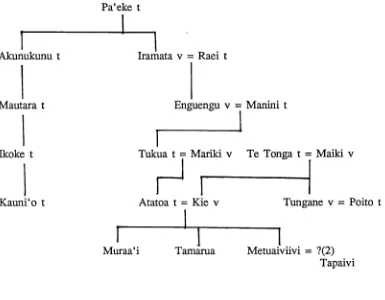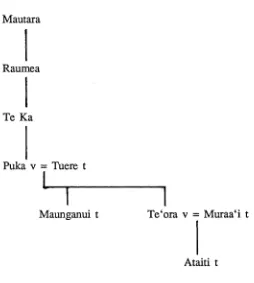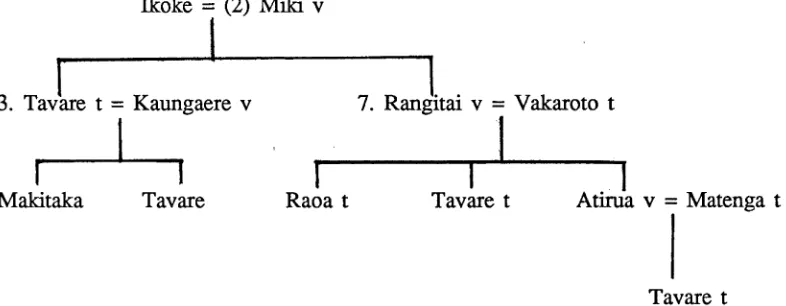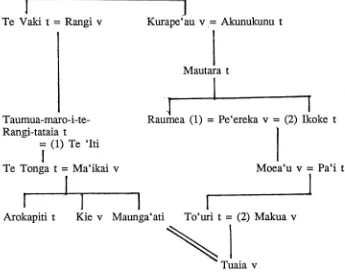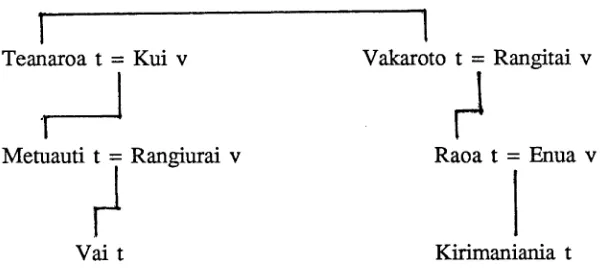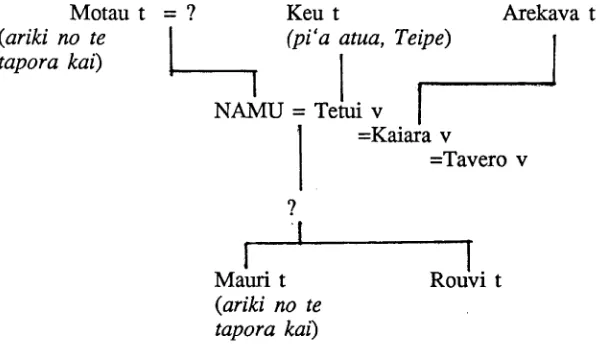IN THE COOK ISLANDS
Michael Patrick Joseph Reilly
A thesis submitted for the degree of Doctor of Philosophy of The Australian National University
Ko Wiremu Parker Ko Ruka Broughton i haere atu i te ara nui a Tane.
Declaration
Except where otherwise indicated this thesis is my own work.
Opuopu te uru e no Mangaia e! No Mangaia!
Kua pueke te ai ki vaenga moana Ki te ata kurakura
The hills of Mangaia are lost to sight Alas for Mangaia!
Torches light our pathway o ’er the sea Where the ruddy sun went down.
ABSTRACT
This thesis applies techniques of textual analysis to selected Mangaian historical narratives. By viewing the texts as literary constructions an historian is able to gain a better perspective of the way the narrations were structured and clothed with particular ethnographic and historical textures. The introduction discusses the principal collectors and the ways they represented their work.
The first part establishes the bases upon which the Mangaian past was told. Despite the transformations experienced since the arrival of the missions a significant degree of continuity can still be found in the roles of traditional experts, in particular of women, and in the ways traditions are transmitted.
The second part explores a selection of Mangaian texts. Chapters four and five delve into the extant versions of a Mangaian origin myth and their categories of the other world—the supernatural. The roles of the ancestral figures and the supernatural beings emphasise the important place occupied by mythological texts in the telling of Mangaia’s past. The physical, cultural and spiritual mapping of Mangaia is established through the conflicts and partial resolutions achieved between the supernatural agencies and the island’s founding ancestor. Chapter six explores the connections between these categories of the otherworld and historically recorded visits to the island. The fearful attitude these visitors provoked and the attempts made by Mangaians to control the encounters reflect the ways Mangaians viewed the world.
iv
island’s peace and prosperity. Conversely, the island suffered when these rulers opposed each other. However, the hierarchical appearance of Mangaian society structured around these complementary rulerships was always leavened by crosscutting personal, family, tribal or religious loyalties which acted to reintegrate society after political conflicts.
Table of Contents
Declaration 1
Abstract iii
List of Figures and Maps vii
Preface viii
Glossary of Mangaian Terms xix
Abbreviations xxiii
INTRODUCTION
1 The Texts of Mangaian History 1
PART 1 MATTERS OF TRADITIONAL KNOWLEDGE
2 Women and Traditional Categories of Expert 3 The Transmission of Traditions
PART 2 TEXTS AND CONTEXTS OF MANGAIAN HISTORY
4 A Mangaian Origin Myth 55
5 ‘Te Anau Tuarangi, the Heavenly Family’ 84
6 The Children of Tangaroa 106
7 The Dreams of Numangatini 147
8 The ‘Peace’ of the Peacemakers 179
9 The Succession of the Peacemaker 190
10 The Passage to Peace 211
11 The Challenge of Arepe‘e 231
12 The Challenge of Ngäti Vara 247
27 40
vi
APPENDICES
A Dating the Darkness/Light Contrast 279
B The Changing Tribe 281
C Mangaian Language Texts 285
D An Example of Gill’s Editing: ‘E Eva, na
Teinaakia, no te Mate ia Tuaopapa’ 308
LIST OF FIGURES AND MAPS
FIGURES
1 Genealogy of Mamae and Tereavai 6
2 Genealogy of Tereevangeria Aratangi 8
3 Genealogy of Rangi and Tumuteanaoa 69
4 Genealogy of Mourua 112
5 Genealogy of Kirikovi and Pa‘i 113
6 Genealogy of Tokoau 113
7 Genealogy of Metuaiviivi 136
8 Genealogy of Muraa‘i and Ataiti 137
9 Genealogy of Tavare 139
10 Genealogy of Maunga‘ati 140
11 Genealogy of Metuauti 141
12 Genealogy of Numangatini 148
13 Priestly Genealogy of Vaeruarau 149
14 Genealogy of Namu 161
15 Genealogies of Te Aoiti, Rau‘ue and Vaipo 228
16 Genealogy of Akaina 243
17 Genealogy of Ngäti Vara 248
18 Genealogy of Akatara and Te Uanuku 253
19 Genealogy of Mautara’s descendants 273
MAPS
The Cook Islands and the Pacific
(Source: R.G. Crocombe, L and Tenure in the Cook Islands (Melbourne, 1964), 5)
xvi
Mangaia
(Source: Te Rangi Hiroa, M angaian Society, BPBMB 122 (Honolulu, 1934), between 4 and 5)
xvii
‘Native Conception of the Geography of Mangaia’ (Source: Auckland Public Library, GNZMSS 45)
viii PREFACE
This historiographical reading of M angaia’s past focusses upon the extant texts and
oral testimony by both Mangaian and non-Mangaian authors. Mangaia, or to use its older
name, A ‘ua‘u, is located in the southern group of the Cook Islands in eastern Polynesia,
about 177 kilometres east by south-east from Rarotonga, the principal island of the group.1
Mangaia lies about 820 kilometres from Tahiti, 1,500 kilometres from the island of Upolu in Western Samoa, and 1,620 kilometres from the island of Tongatapu in Tonga.2 In the
early nineteenth century the Mangaian population was estimated at between two and three thousand.3 In 1981 it totalled 1,364.4 The total land area of Mangaia is 51 square
kilometres.5
The island’s most distinctive physical feature is the makatea, the craggy limestone cliffs which rise up above the desolate and barren coastline. These cliffs reach as high as
60 metres and in breadth measure anywhere between 60 and 1,500 metres. Lying in the interior of the island, between the makatea and the central mountain, Rangimoti‘a, 169 metres above sea level, are the irrigated plots where the staple food, the taro, is cultivated. Access from the sea edge to the interior, except in a few places, is next to impossible.6
Since at least the early nineteenth century Mangaia has been divided into six districts
{puna), each of which is subdivided into subdistricts (tapere). The six puna are presently
called K ei‘a, Veitatei, Tamarua, Ivirua, Karanga and Tava‘enga. These districts commence
1 Pacific Islands Yearbook, ed. Norman and Ngaire Douglas, 16th ed. ([Sydney], 1989), 51.
2 Admiralty Distance Tables: Volume V: Pacific Ocean, 2nd ed. (London, 1953), 71. The
figures were originally in miles and calculated the distances from Rarotonga. My conversions are only approximate and are adjusted to allow for the additional distance to Mangaia.
3 A discussion of the statistics for Mangaia’s population in the nineteenth century in Norma McArthur, Island Populations of the Pacific (Canberra, 1968), 175—79, and table 34.
4 Pacific Islands Yearbook, 35. The population has not varied greatly this century. E.g.
McArthur, table 35; Pacific Islands: Volume II: Eastern Pacific, B.R. 519 B (Restricted), Geographical Handbook Series, Naval Intelligence Division (n.p., 1943), 523.
5 Pacific Islands Yearbook, 39.
from Rangimoti‘a and fan out in a wedge-shape to the sea shore. (See the accompanying
map, p. xvii, for an illustration of these land boundaries.) All the divisions of land are
under the rule of district chiefs (kavana) and subdistrict chiefs ( ‘ui rangatira). These chiefs trace their title to an allocation of land near the beginning of the nineteenth century. They
remain responsible for arbitrating in land disputes and generally maintaining the peace.7
The Mangaians retain a strong sense of cultural uniqueness.8 Outsiders, whether
Europeans (Papa‘ä) or other Cook Islanders, are treated with a surprising degree of reserve. One expatriate Mangaian woman described the attitude as ‘looking you up and down and not caring’.9 This attitude is extended to the domain of politics. The Cook Islands Land
Court which functions on all the other islands in the group has never been permitted a
toehold in Mangaia. Even non-Mangaian pastors of the Cook Islands Christian Church (hereinafter the CICC, formerly the LMS), the de fa cto established church in these islands,
find great difficulty settling in on Mangaia where the local community seems to prefer ministers from their own island. When discussing the local treatment of outsiders Mangaians are always ready to admit that before Christianity their ancestors killed such
people; however, they stress that visitors are treated much better today.
Mangaians possess a conservative culture, holding on strongly to a sense of the past. This is reflected in different aspects of their life. Locals will describe themselves as
7 Cook Islands Notebook No. 1, information from the ‘ui rangatira of the Tei-ia-roa tapere in Karanga, Pökino Aperahama, 2 May 1988. Aperahama is a former Chairman of the Island Council and member for Mangaia in the Cook Islands Parliament. Cf. this view of the chiefs with that of Papa Aratangi who believes that the kavana are the cause of many disputes, taking lands for their own families and looking down on the ‘ui rangatira. ‘The Entry of Christianity into Mangaian Society in the 1820s’ (BD Project, Pacific Theological College, Suva, Fiji, 1986), 75.
8 The following discussion of Mangaia is derived from the author’s own observations while on a brief visit to the island in 1988. Given the brevity of my stay these comments are not meant as definitive but rather to sketch the state of things as one outsider perceived them at a particular point in time.
Parate‘e (British); they treasure a Union Jack given by Queen Victoria;10 children can be
heard singing ‘God Save the Queen’ along with church hymns. Since the Cook Islands
became independent of New Zealand in 1965 Mangaians have talked of breaking away from the new state and seeking political integration with the United Kingdom or New
Zealand.
An important feature of life on Mangaia is the place of the CICC. This church is
intimately bound up with the government of the island. The chiefs are church deacons and also the senior government officials on the island. This relationship is often seen as a
continuation of the old pre-Christian social structure within the new.* 11
There are three CICC churches each located in one of the island’s three villages near the coast line: Oneroa, Ivirua and Tamarua. The kavana remain responsible for looking
after the church pastors and for the upkeep of the buildings. The ministers and their
families regularly receive gifts of food from their parishioners.12 Threats to the authority of the church are taken seriously by Mangaians. Recently, more fundamentalist Protestant groups have converted some Church members including CICC deacons, to the evident concern of the pastors, the chiefs, and indeed the Church authorities in Rarotonga.13
The historian, unlike these recent missionaries, does not arouse such a degree of concern, provided his or her interest is kept within the scholarly domain. The Mangaians whom I spoke to took a great interest in any such enterprise. One ‘ui rangatira even
10 Tereevangeria Aratangi, a tumu korero (traditional expert), related an account that the ariki (high chief, king) of Mangaia met Queen Victoria during a visit to the Pacific. He was the second to last to meet her, followed only by the King of Tonga. The ariki received a walking stick, a stamp [a seal ?], and the flag. Cook Islands Notebook No. 1, 28 April 1988.
11 This idea of continuity within Mangaian society and especially in its religious beliefs is referred to by Papa Aratangi, ‘The Transformation of the Mangaian Religion’ (Master of Theology thesis, Pacific Theological College, Suva, Fiji, 1986), e.g. 109--14.
12 Watching these gifts from the back verandah of the Oneroa pastor’s house I was reminded of the offerings formerly given to atua (deities) and their p i‘a atua (priest) in pre-Christian Mangaia. This theme of the old continuing within the new is often encountered in present day Mangaian society.
expressed his wish that a comprehensive ethnographic study of the island might be undertaken. 14 Whether this was a hint that I ought to change topics was never made clear.
He certainly believed such knowledge could only advance Mangaia’s interests. I hope that the texts of the island’s past which I will analyse and retell may help further such an ambition.
When quoting Mangaian I have followed a few simple conventions. Mangaian texts are cited in italics to distinguish them from their English translations. The use of a different font is not meant to imply that the Mangaian occupies an inferior textual position to the English prose. Quotations from Mangaian sources which are incorporated in the body of the English narrative or the titles of vernacular texts are given in quotation marks.
When quoting Mangaian songs I have relied upon the vernacular text in the original manuscript or manuscripts where these exist. This practice was necessary since Gill tended to amend Mangaian words in an apparent attempt to harmonise them with other island usages. Such a practice is particularly noticeable in the case of the Mangaian verbal particles ‘ua, ‘ia, ‘a and the focus particle ‘o which he often rendered as kua, kia, ka and ko. In some cases however the Mangaian authors themselves used both forms, sometimes within the same text.
I have not changed the spelling, punctuation, division of words or the use of diacritics in the Mangaian quotations. The nineteenth century writings in particular regularly use macrons where modem practice would dictate the employment of the glottal stop.
I have made no editorial changes to the texts to bring them into line with modem practices for two reasons. First, it is in keeping with good historical practice to present the Mangaian text as near as possible to its original state. The use of italics has been adopted to aid readability. Second, it would be impossible—however desirable-to adopt a more consistent policy regarding the use of diacritics as the current published dictionary
14 Author’s recollection of a conversation with several Oneroa deacons including the ‘ui
xii
for Rarotongan Maori, which is also the main aid for Mangaian, inserts them very haphazardly.15 Earlier publications are equally unhelpful. The Cook Islands Bible (Te
Bibilia Tapu) only inserts macrons for words the meanings of which would otherwise be
unclear.
Proper nouns are marked with diacritics where the textual sources are in a large
measure of agreement. The spelling of these names varies from text to text. I have tried
to include all the variants while opting to use the most commonly accepted form. Certain Mangaian terms and phrases which appear regularly in the text are listed, with an English
explanation, in a glossary.
Unless otherwise noted I am responsible for all the translations and interpretations
of Mangaian. When translating Mangaian texts I have endeavoured to keep to a more
literal than literary reading, so as to ensure as much accuracy as possible. This has often meant amending G ill’s translations of Mangaian song poetry which tended to be influenced
more by considerations of good verse than textual accuracy.16 Any errors of translation which a reader may detect are therefore solely of my own making.
Many people and institutions have helped make this thesis possible. The Australian National University provided me with a Ph.D Scholarship and financed my Pacific fieldwork. The Government of the Cook Islands gave me permission to undertake research in the islands. I especially wish to acknowledge the assistance of the Honourable N.
David; the Secretary of the Prime M inister’s Department, Tuiau Tongia; and the Honourary Commissioner to the Cook Islands in Australia, Michael Nicholas.
15 Stephen Savage, A Dictionary o f the Maori Language o f Rarotonga (Wellington, 1962). The only published source for Mangaian is the word list written by F.W. Christian, Vocabulary o f the Mangaian Language, Bernice P. Bishop Museum Bulletin 11 (Honolulu, 1924; reprint, New York, 1971). Christian’s work was the subject of unfavourable comment by the Polynesianist, S. Percy Smith. S. Percy Smith to H.E. Gregory, 11 June 1921, Polynesian Society Papers Acc 80-115, Box 4A Correspondence. Given the small number of words I have not relied upon Christian’s work very much.
The Cook Islands Christian Church did much to facilitate my stay in the islands, both in Rarotonga and on Mangaia. I wish to thank the Executive Council of the CICC, and in particular, Tere Mataio, the Secretary General; the Principal and students of the Takamoa Theological College; and especially my host family while in the college, Ni‘o and Eti Mare. On Mangaia the church officers at Oneroa assisted my visit. The Reverend and Mrs Temere Poaru kindly extended to me the hospitality of their home. I remain especially grateful for the way in which they and their children, particularly Märere and Viliamu, accepted me into their family life. While on Mangaia I received much assistance from two visiting theological college students Tana Ta‘ua‘i and Mauri Paulo.
Many people gave me valuable help during my fieldwork and subsequent research. On Mangaia a number of individuals gave freely of their time and knowledge including the late kavana Rape Harry; the ‘ui rangatira Pökino Aperahama, Atingakau; and Tereevangeria Aratangi. Bishop Leamy of Rarotonga permitted me to consult papers in the Catholic diocesan archive. Niel Gunson provided me with relevant material derived from his own research in the United Kingdom and in the Cook Islands. Papa Aratangi extended my knowledge of Mangaia, sought out additional information, and translated some of the texts used in the thesis. Marivee McMath and Donald Marshall generously shared their knowledge and writings about Mangaia. Kauraka Kauraka answered queries about the modem recording of traditions in the Cook Islands. Members of the Tupa family in Takuva‘ine, Rarotonga, welcomed me back into their family after twelve years. Eric Casino smoothed my path in Hawaii while Renato and Josephine Cmz provided me with handy accommodation.
xiv
In New Zealand: the Alexander Turnbull Library, the National Library of New Zealand; the National Archives of New Zealand; the Auckland Public Library; the Auckland Institute and Museum Library; the Hocken Library, University of Otago; and the Libraries of the Universities of Auckland, Otago, and the Victoria University of Wellington.
In the Cook Islands: Carmen Temata and the staff of the Cook Islands Library and Museum; George Paniana of the National Archives of the Cook Islands; Sister Margaret and the archives of the Roman Catholic diocese of Rarotonga; the volunteer staff in the Genealogical Library of the Church of Jesus Christ of the Latter Day Saints; and the CICC records at the Takamoa Theological College.
In Honolulu: the Bernice P. Bishop Museum Library; the Hawaiian Mission Children’s Society Library; and the Thomas Hale Hamilton Library of the University of Hawaii at Manoa. Copies of relevant documents were kindly sent to me by James H. Hutson, Manuscript Division, the Library of Congress, in Washington, D.C.; Alan F. Jesson, the Bible Society’s Librarian, Cambridge University Library; and officers of the Inter Documentation Company, Leiden, The Netherlands, who provided microfiches of parts of the Religious Tract Society correspondence.
Many people have contributed to the intellectual shaping of this thesis. I owe most to my supervisor, Niel Gunson, who gave good counsel and always showed a keen interest in what I was discovering. I also wish to acknowledge my advisers: Gavan Daws, Donald Denoon and Darrell Tryon. Ranajit Guha introduced me to the world of semiotic and structuralist readings. Bob Langdon happily shared his knowledge of the Pacific. I also received help from Kieran Schmidt, Dorothy Shineberg, Jennifer Terrell, and Toon van Meijl.
department I was given much practical and scholarly advice by staff and student colleagues. The help I received from Phyllis Herda, Ruurdje Laarhoven, Klaus Neumann and Twang Peck Yang deserves special mention. I also profitted from the discussions in a number of student reading seminars in the Departments of Pacific and Southeast Asian History and Anthropology; the latter was organised by Ton Otto who kindly invited this historian along.
These acknowledgements would not be complete without putting on record my especial thanks to the family, friends and acquaintances who gave me help and support. A particular thankyou to my parents who never seem to doubt their children’s abilities; to
Vi
0 1
—1
oo
GLOSSARY OF MANGAIAN TERMS
a ‘i kavere = meal consumed when experts meet to discuss historical and traditional lore (Te) ‘Akatauira = second bom grandson of Rongo, second ariki pa uta, the first kai',
eponymous ancestor of Te ‘Akatauira subtribe of Ngariki
Te ‘Ämama = family of the priests of Motoro; alternative name for Ngäti Vara or Ngäti Mautara
‘änau = family
‘aö = the people defeated in battle who consequently lost their land and lived in various refuges or under the protection of victorious chiefs
‘are ei ‘au = miniature house for peace, representing the rule of a new mangaia, built on each marae
‘are körero = a form of traditional expert; see körero.
ariki = in pre-contact Mangaia the island’s spiritual rulers or high priests who officiated at various ceremonies; today the titular ruler of the island: ariki karakia = praying high priest, alternative name for the senior priest, the ariki pa uta', ariki pa tai = seaward spiritual ruler or shore high priest; ariki pa uta = interior spiritual ruler or inland high priest; ariki no te tapora kai = spiritual mler or high priest responsible for food aronga mana = the group (of) power; the collective chiefs
atua = god or deity; see io\ shortened form of p i‘a atua ‘au = peace, rule, reign; alternative name of mangaia ‘Avaiki = Mangaian spirit world
Avatea, Vätea = divine father of Tangaroa and Rongo, husband of Papa-ra‘ira‘i, son of the Mangaian genitrix Vari-ma-te-takere
etene = heathen, referring to ancestors of Mangaian Christians eva = dirge or lament
ika, mangaika = fish; human sacrifice io = god or deity; see also atua Ivirua = district of Mangaia
kai = food; a subsidiary title of the mangaia sometimes held separately though remaining in the temporal ruler’s gift
kaiparau = bookeater, designating the Christian converts in early nineteenth century Mangaia kairanga nuku = pre-contact subdistrict chief, replaced by ‘ui rangatira
Karanga = district of Mangaia
kavana = modem district chief, derived from English term governor; see also pava
kea inamoa = sacred stone on Orongo marae, site of human sacrifice and installation of ariki\ alternative name koatu karakia
Kei‘a = district of Mangaia
kiko mua = first flesh, signifying the first bom of a marriage
kiore = pre-contact Mangaian rat; alternative name for human sacrifice, see ika koina-rä = alternative name for the mangaia, temporal ruler
köpü (tangata) = tribe or family; köpü ika = a tribe dedicated for the human sacrifice to inaugurate a new mangaia
körero = a form of traditional expert; a tribal historian; storyteller; probably corresponds with Gill’s ‘wise man’ or ‘wise woman’; other synonymous terms are ‘are körero and tumu körero
koromatua = pre-contact religious expert; according to Gill he was responsible for instructing the ariki\ also called korometua
makatea = ecological zone, limestone cliffs surrounding Mangaia’s interior manu = animal; bird; messenger; person
mangaia = pre-contact temporal ruler, also called the ‘au, or koina-ra\ peace mangaika = see ika
marae = pre-contact religious structure
maro = traditional garment: man’s girdle or loin cloth; maro aitu = a special sacred maro used in certain Mangaian religious rituals
maunga = mountain, referring to central hill of Mangaia, an ecological zone; see Rangimoti‘a
mokopuna = grandchild(ren)
Motoro = second ranking deity of Mangaia, associated with Ngäriki
Ngäriki = founding tribe of Mangaia, descended from Rangi, Te ‘Akatauira and their brother Mokoiro
ngäti = tribe; part of a tribal name, e.g. Ngäti Vara, Ngäti Täne Ngäti Mana‘une = Mangaian tribe
Ngäti Täne = Mangaian tribe
Papa-ra‘ira‘i, Papa = divine mother of Tangaroa and Rongo, wife of Avatea or Vätea Päpärangi, Ngäriki = subtribe of Ngäriki, descended from Rangi, eldest son of Rongo p a ‘u aka au = ceremonial drum used during inauguration of a new mangaia to announce
peace
pava = pre-contact district chief, replaced by kavana
p e ‘e = a category of Mangaian song containing much historical information Tepei, Teipe = a tribe or subtribe associated with Tonga‘iti
p i ‘a atua = literally ‘receptacle (of the) god’; priest; also known as pi a or atua poke = a pudding-like food
puna = district
raei = part of the makatea, traditional refuge for the dispossessed
Rangi = eldest grandson of Rongo by his daughter Tavake, founding ancestor of Mangaia, first ariki and mangaia
rangi = heavens, sky; more correctly, the ethereal space; the not-earth region
RangimotPa = central mountain of Mangaia, refuge, site of religious rituals in pre-contact era
Rongo = second born son of Vätea and Papa, usurping brother of Tangaroa; principal god of Mangaia
ta‘ae = a category of supernatural being: demon, monster; something monstrous, fierce, wild tai = seashore
tama'ine = daughter
Tamarua = district of Mangaia
tama täne = genealogical connection through the father tama va‘ine = genealogical connection through the mother
Tangaroa = eldest son of Vätea and Papa, supplanted by Rongo; the absent deity of Mangaia tangata purepure = sorcerer or sorceress; also taunga purepure
tapairu = a category of supernatural being, usually female, often described as daughters of Miru, goddess of the otherworld; eldest daughter of a chief
tapere = subdistrict
ta‘unga = expert; a craftsman
xxii
Tava‘enga = district of Mangaia
teina = younger brother, sister or cousin of same sex
teka = game of dart throwing; taua teka = arena for dart throwing game tiaki = keeper or caretaker
tikoru, tikoru mataiapo = a thick, white paper-mulberry cloth worn by god-figures, spiritual rulers, priests and leading chiefs on marae\ cloth covering entrances to sacred buildings
toa = warrior; ironwood tree toki = adze; axe
toko = chiefly military supporter or executive of incumbent or aspirant mangaia; stick on marae representing support for the mangaia
Tonga4iti = Mangaian tribe, contested control of island with Rangi, virtually wiped out in early nineteenth century
tuaine - sister of a brother
tuakana = elder brother, sister or cousin of the same sex tape = a game, resembling quoits
(pa) tuarangi = a general term for all supernatural beings, including spirits, ghosts, non- Mangaian human beings; also called vaerua kino\ horizon
tumu körero = a form of traditional expert; see körero
Tumuteanaoa (Echo) = sister of Vatea and senior daughter (tuakana) of Vari-ma-te-takere, aboriginal inhabitant of Mangaia discovered by Rangi
tuna = eel
tüpäpaku = a supernatural being; ghost; also called mauri tupuna = grandparent(s)
uta = inland
utu = a tree, barringtonia speciosa vaerua, värua = spirit; ghost; soul
Vaeruarangi = subtribe of Ngariki, descended from youngest son of Rongo, Mokoiro; holders of the ariki no te tapora kai
ABBREVIATIONS
A series of abbreviations are used throughout the footnotes for commonly cited references:
Advent = Te Rangi Hiroa (Peter H. Buck), ‘Notes towards "Advent of Christianity" in the Cook Islands’, MS SC Buck Group 3 Box 7.5, BPBML.
B = [Mamae], ‘Genealogical Tables of Te ‘Amama or Ngati-Vara tribe’, MS Case 5 Co 2, Bernice Pauahi Bishop Museum Library (BPBML). It is often cited as the Bishop typescript in the thesis text.
Bmm = ‘Mangaian Mythology’, MS SC Buck Group 3 Box 7.1, BPBML. CIC = William Wyatt Gill, Cook Islands Custom (Fiji, 1979).
DL = William Wyatt Gill, From Darkness to Light in Polynesia with Illustrative Clan Songs (London, 1894; reprint ed. [Fiji], 1984).
G 44 = William Wyatt Gill, ‘Original MSS of Historical Sketches o f Savage Life in Polynesia [earlier title of From Darkness to Light]*, GNZ MSS 44, Grey Collection, Auckland Public Library (AP).
G 45 = William Wyatt Gill, ‘Original MSS of Native Songs etc., used in his Myths and Songs and Historical Sketches of Savage Life’, GNZ MSS 45, Grey Collection, AP. Jottings = William Wyatt Gill, Jottings from the Pacific ([London], 1885).
Life = William Wyatt Gill, Life in the Southern Isles; or, Scenes and Incidents in the South Pacific and New Guinea (London, [1876]).
M = Stephen Savage, Collection of Books and Articles, Births, Deaths, Marriages, Wills, Church of Jesus Christ of the Latter Days Saints Genealogical Library, Avarua, Rarotonga, Cook Islands, reel no. ILC # 0039. It is often cited as the Mormon manuscript in the thesis text.
MangS = Te Rangi Hiroa (Peter H. Buck), Mangaian Society, Bernice Pauahi Bishop Museum Bulletin 122 (Honolulu, 1934).
Mi 131, 132 = William Wyatt Gill, ‘Rarotonga Notes, Songs, Stars, Stories, [and] Letters’, National Library of New Zealand, Alexander Turnbull Library, Polynesian Society MS Papers 1187, folder 59, micro 131, 132.
MK = National Archives of the Cook Islands, Cultural Development Division, Ministry of Social Services, Mangaian Korero Series, 1975.
MP = Te Rangi Hiroa (Peter H. Buck), ‘Mangaian MS Parts’, MS SC Buck, BPBML. M&S = William Wyatt Gill, Myths and Songs from the South Pacific, preface by F. Max
Müller (London, 1876).
SSL = Council for World Mission Archives (formerly the London Missionary Society (LMS)), South Seas Letters.
xxiv
INTRODUCTION
ONE
THE TEXTS OF MANGAIAN HISTORY
M angaia’s past is told in a series of texts recorded since the mid-nineteenth century
until the present. Some were written by Mangaians last century, drawing on the oral traditions of their tribal and family groups. In 1975 local experts recorded stories which
were later transcribed into written texts. Since the nineteenth century non-Mangaian scholars have published the island traditions drawing upon the written and oral testimony of indigenous associates. An examination of these collectors and recorders and the texts
they prepared provides the context for the island’s past.
Despite M angaia’s depth of historical documentation and the breadth of recording by both local and European scholars little historical work has been done recently.1 Even less
effort has been expended in attempting to critically re-examine the existing historical literature.2 This situation, which exists more generally in the study of history in the Pacific,
has led to a call for the application of new techniques of textual criticism to the ‘traditional texts’.3 Such an application could learn much from other fields of history which have long
1 Papa Aratangi, a Mangaian pastor, has written on Mangaia’s religious history using published sources and local traditions derived, in part, from his mother, Tereevangeria Aratangi, a tumu körero (traditional expert). See ‘Entry of Christianity into Mangaian Society’; ‘Transformation of the Mangaian Religion’.
2 Two anthropologists have analysed certain parts of Mangaia’s mythological literature. See Christian Campbell Clerk, ‘The Animal World of the Mangaians’ (Ph.D thesis, University College, London, 1981), chapter 10; ‘The Fish of Rongo: Some Readings of a Polynesian Myth’, Folklore 96, 2 (1985), 234-42; Mary V. Mark, ‘The Relationship between Ecology and Myth in Mangaia’ (M.A. thesis, Otago University, 1976), chapter 7.
2 used textual sources.* * * 4 Two textually-oriented fields of practice have influenced the present re-exploration of M angaia’s historical literature: hermeneutics and structuralist-inspired literary criticism.
The term hermeneutics means, in essence, to clarify the unclear and corresponds to
interpretation.5 In biblical studies hermeneutics or interpretation has historically taken the
form of a commentary. In this sense it is synonymous with exegesis or exposition.6 When applied to a text an exegesis can be understood as the ‘reading out’ of the work’s
meaning.7
Recent biblical scholars have emphasised how this ‘reading out’ is conditioned by the text’s actual language—its ‘linguisticality’.8 For the historian, equipped with his or her
own baggage of beliefs and prejudices, this medium of language forces an engagement with
Gods of ‘Upolu and Savai‘i‘: A Samoan Story from 1890’, Journal of Pacific History (JPH) XXm, 1 (April 1988), 80-85.
Past and present discussions of Pacific History as a practice include, J.W. Davidson, The Study o f Pacific History An Inaugural Lecture delivered at Canberra on 25 November 1954 (Canberra, 1955); ‘Understanding Pacific History: The Participant as Historian’; ‘History, Art or Game? A Comment on ‘The Purity of Historical Method” ; Gavan Daws, ‘On Being a Historian of the Pacific’; K.R. Howe, ‘The Fate of the ‘Savage’ in Pacific Historiography’; H.E. Maude, ‘Pacific History-Past, Present and Future’; Caroline Ralston, ‘Writing Pacific history: The State of the Art’. Full citations are given in the Bibliography.
4 Southeast Asian History, with its shared Austronesian heritage, might be a profitable field. E.g. A.H. Johns, ‘The Turning Image: Myth and Reality in Malay Perceptions of the Past’, in Perceptions o f the Past in Southeast Asia, ed. Anthony Reid and David Marr (Singapore, 1979), 43-67.
5 James M. Robinson, ‘Hermeneutic since Barth’, in New Frontiers in Theology. Discussions among Continental and American Theologians. Vol. II: The New Hermeneutic, ed. James M. Robinson and John B. Cobb, Jr (New York, 1964), 1.
6 John H. Hayes and Carl R. Holladay, Biblical Exegesis: A Beginner’s Handbook (London, 1983), 5; Robinson, 5-6. Some biblical scholars came to distinguish hermenutic as the theory and exegesis as the practice of the art of interpretation. Some scholars still accept this distinction. E.g. ‘Exegesis and Hermeneutics, Biblical’, in Encyclopaedia Britannica, 8 (1969), 949. Others do not. E.g. Paul Ricoeur, Essays on Biblical Interpretation, ed. Lewis S. Mudge (Philadelphia,
1980), 49, 143; Robinson, 5-6. 7 Hayes and Holladay, 5.
the text itself. The two are engaged, as one writer put it, in a ‘play of understanding’;
both possessing ‘horizons’ of vision; the interpreter’s in the present and the text’s in the past.9 The hermeneutical text retains its own integrity as a work while shaping and being
shaped by the historically-aware participant.
For an historian of Mangaia hermeneutics stresses the importance of comprehending the indigenous texts on their own terms and not straitjacketing them within foreign theories
or the historian’s own interests. The texts should determine the history. The indigenous
language too ought to be granted a privileged position in the discourse.
The structural analysis of literary texts originates from Levi-Straussian structural
anthropology.10 Its practice was adapted by Roland Barthes in the field of semiology--the science of signs. Barthes viewed semiology as ‘a bringing into the open of aspects of meaning ignored by orthodox disciplines’.* 11 He believed a text was a speech, ‘a message
which refers to a code’, that semiology sought to clarify or unfold.12 Barthes broke up or segmented a text into its constituent units of reading (also called lexias, speech fragments
or material signifiers). This segmentation allowed a reader to elicit the many meanings, or codes as Barthes called them, which a text contained and to connect it with other texts
and the wider narrative situation.13
9 Gadamer, Truth and Method, 129, 269-73; ‘On the Problem of Self-understanding’, in Philosophical Hermeneutics, 53—54, 56-57. A number of other images are suggested by Gadamer including those of the conversation and a dialectic. E.g. Truth and Method, 347, 357-58.
10 E.g. Claude Levi-Strauss, ‘The Structural Study of Myth’, in Claude Levi-Strauss, Structural Anthropology, trans. Claire Jacobson and Brooke Grunfest Schoepf (Harmondsworth, Middlesex, 1968), 206—31; ‘The Story of Asdiwal’, ‘Four Winnebago Myths’, in Structural Anthropology volume 2, trans. Monique Layton (Harmondsworth, Middlesex, 1977), 146—97,
198—210; The Savage Mind (London, 1966); Edmund Leach, Levi-Strauss (London, 1970). 11 Jonathon Culler, Barthes ([London], 1983), 71.
12 Roland Barthes, ‘The Structural Analysis of Narrative: Apropos of Acts 10—11’; ‘The Textual Analysis of a Tale by Edgar Allan Poe’, in Roland Barthes, The Semiotic Challenge, trans. Richard Howard (Oxford, 1988), 224-25, 264.
4 Unlike hermeneutics semiology, according to Barthes, did not tunnel towards a
narrative’s deep structure:
It does not seek the secret of the text: for it, all the text’s roots are in the air; it does not have to unearth these roots in order to find the main one.u
A biblical exegete, commenting on Barthes’ utterance, more prosaically suggested that whereas hermeneutics was concerned with the depth and intention of a text, structural
analysis dealt with the text’s surface and pattem .15 A segmentation of M angaia’s written past may not only expose the varied meanings held within a text but yield up fresh ways
of viewing the history which the narratives retell.
The written record of M angaia’s past begins with the compositions by nineteenth century Mangaians. They wrote at the behest of the missionary who did so much to make Mangaian traditions known to the scholarly world, William Wyatt Gill. His principal
Mangaian contributors were Mamae, also called Sadaraka or Koroa-iti, and Tereavai, or Te M am .16 At the time that Gill knew them Mamae was a respected pastor and Tereavai a
deacon at Tamarua in Mangaia.17 Both men were members of the Ngäti Vara tribe. Mamae was a grandson of Koroa, a former mangaia, or temporal ruler—the supreme political ruler of the island—with whom Mamae lived as a child.18 Tereavai until about
14 Barthes, ‘Structural Analysis of Narrative’, 228; also see ‘Edgar Allan Poe’, 262.
15 Alain Blancy, ‘Structuralism and Hermeneutics’, in Structuralism and bibBical Hermeneutics, ed. and trans. Alfred M. Johnson, Jr. (Pennsylvania, 1979), 84.
16 G 45, Note by Gill; M&S, xx. Judging from other sources Te Mam appears to have been an alternative name for Tereavai. See Chapter 10 for details.
17 There are many attestations to Mamae’s distinguished position. E.g. DL, 367-68; Takamoa Theological College, Rarotonga, List of Students, Entry no. 9; SSL, William Wyatt Gill (WWG), 1 July 1857. He was placed in charge of the church during the absence of the missionary. SSL, WWG, 30 October 1858; SSL, G.A. Harris (GAH), 23 October 1883. Harris described Mamae as his co-adjutor. SSL, GAH, 5 June 1879. Mamae co-signed Mangaian letters to the Directors of the London Missionary Society (LMS). SSL, 29 December 1864; SSL, 3 June 1865. See also SSL, WWG, 5 January 1865. In 1858 Mamae, or Sadaraka, organised the ‘king’ (Numangatini) and the chiefs ‘to exert their authority’ to save a ship wrecked at Oneroa. WWG, Letter, Missionary Magazine and Chronicle (MMC) (1 July 1859), 193-94. In 1879 he tried to mediate a serious succession dispute following the death of the ariki, Numangatini. SSL, GAH, 5 June 1879. Tereavai’s career is described in SSL, WWG, 27 April 1865.
1828 or 1829 had been p i‘a atua (priest) of the Ngäti Vara atua (god, deity) Tiaio or Te Aio.19
The Ngäti Vara, also known as Te ‘Ämama or Ngäti Mautara, were descended from the p i‘a atua of Motoro, the second-ranking atua of Mangaia and the tribal divinity of the island’s original settlers, the Ngäriki.20 For many years the Ngäti Vara ruled the island but shortly before the arrival of Christianity in 1823 they lost power. They remained opposed to the new faith accepted by the ruling tribes and attacked its followers. They were eventually defeated in 1828. Subsequently they were integrated into the victorious Christian community, though a number remained pagan; the last non-Christian only entered the church in 1865.21
In 1975 the Cook Islands government under Albert Henry initiated the collection of island traditions from local experts. Henry had long believed in the importance of preserving indigenous traditions for future generations; traditions were to be used to reinforce the distinctive identity of the nation state.22 The collectors were officials of the Cultural Development Division in the Ministry of Social Services which had been established to undertake this task. Some at least of the officers were native to the island
19 Ibid., 312 fn. 1, 335-36; SSL, WWG, 27 April 1865. See Figure 1 for a genealogy of Mamae and Tereavai.
20 See Chapter 12 for further details on the Ngäti Vara.
21 Life, 51; M&S, 188; SSL, WWG, 8 January 1866; WWG, Letter, Evangelical Christiandom (1866), n.p.
6
Figure 1: Genealogy of Mamae and Tereavai23
Mautara t = Te Ko v
(2) Raumea t = Pe‘ereka v = (3) Ikoke t
I
r
1Te Maru t = Te Kena v Potiki t = Tira‘aroa v
Rautaiki t = Taura v
Tuka t = (1) Amama v
Tereavai t = (1) Tangi v
Koroa t = Rurungapu v
T a‘uapepe t = Rou v
Koroa-iti t = Aravao v
Aiteina t
[image:32.544.123.423.218.529.2]from which they collected.24 Material was obtained from recognised körero or experts in
traditional knowledge.25 The information was tape recorded and later transcribed.26 The Mangaian tumu körero were all members of the politically dominant Ngäti
M ana‘une and Ngäti Täne coalition that had wrested power from Ngäti Vara in the
nineteenth century. Several were descended from or held traditional high political offices.
Two körero, Tereevangeria Aratangi and Iviiti Aerepo, sister and brother, provided the bulk of the information. Aerepo, who lived at Tamarua, died in 1978.27 Aratangi, bom in April
1922, is a Ngäti M ana‘une and is descended from Aitama, also called Arapökino, Pökino
or Samuel (Samuera), the toko (military supporter) of the last mangaia Pangemiro.28
24 Cook Islands Field Diary, 10 May 1988, information from George Paniana, National Archives of the Cook Islands (NACI); Kauraka Kauraka to author, 19 October 1989; information in Mangaian körero series (MK), NACI; Clerk, ‘Animal World of the Mangaians’, 41.
Two of the recorders for Mangaia were identified; Maki Areai, then in his early twenties and presently a Community Development Officer; and Mataora Harry, the present Principal of Mangaia College, who is the son of the late kavana, Rape Harry, who died in 1989.
25 The term körero is sometimes replaced by tumu körero or ‘are körero. The first term is strictly translated ‘the source or foundation of knowledge’; it has been extended to mean the person who imparts the knowledge as well. The second term, ‘are körero, simply refers to the building in which the traditions are told. Savage, 116.
26 It should be pointed out that these transcripts contain a number of faulty readings presumably due to the difficulties encountered in typing texts from the spoken word. The typescripts also do not mark long vowels or glottal stops.
27 Papa Aratangi to author, 21 March 1989. Since this letter was written in English I cannot be more specific as to what ‘brother’ signified; no genealogy was supplied.
28 Cook Islands Notebook No. 1, information from Tereevangelia Aratangi, 28 April 1988, translated by Iana Ta‘ua‘i, a Mangaian student at the Takamoa Theological College, Rarotonga.
See Figure 2 for a genealogy of Aratangi.
8 Figure 2: Genealogy of Tereevangeria Aratangi29
Pangemiro t
Aitama t = Taeva v
(1) Samuera Aitama t Manoaariki v = Rotane t
I
-Tuaiva = Rotane Ngarangi v Arapoiti t
(4) ‘Aerepo-pokino = Tua v
(10) Tereevangeria = Aratangi
(10) Papa(mama) Aratangi
[image:34.544.91.391.148.464.2]Aratangi made clear her reasons for telling Mangaian traditions: she feared that the
past and its values were not being transmitted to the young.30 The ancestors had known
the traditions about the land, tribes and the good news. She spoke of them as cherishing (‘akaperepere’) Christianity, having forsaken their own gods to worship the Christian one.
She contrasted such enthusiasm with the present where Christianity had grown enfeebled
(‘ei tupuanga paruparu’), diminutive (‘aka mea ngiti’) and become a plaything (‘ei mea kanga’).31 She called on the elders to come forward in a spirit of cooperation to provide information for the government’s recording project so that the young would not become
ignorant (‘neneva’), or have their lands taken by other tribes (‘iti tangata ke’). The task
for her was not the disinterested retelling for some collector’s benefit but a collaborative
project aimed at avoiding what she imagined was otherwise inevitable, the loss of M angaia’s traditional knowledge amongst the young. This loss was intimately connected
to the maintenance of all that made their life worthwhile: peace and equitable social relationships.
Her concerns are at least in part a response to contemporary social concerns. Since the 1936 census the Cook Island population has suffered from increasing emigration while the proportion of the population under the age of 15 has steadily increased.32 One of the
30 MK, Tereevangeria Aratangi, ‘Tuanga Rua: To tatou oraanga i teia tuatau nei e ta tatou angaanga e rave nei’. Aratangi made similar points in several other pieces. See MK, ‘Te Mateanga o Kokiri’, ‘Te Rauka anga mai o teia ingoa Ngatoki’, ‘Te Paopao’.
A similar view of the problems of the past and the present can be found elsewhere in the Pacific. See Robert Borofsky, Making history: Pukapukan and Anthropological Constructions o f Knowledge (Cambridge, 1987), 97; Robert I. Levy, Tahitians: Mind and Experience in the Society Islands (Chicago, 1973), 50; Klaus Neumann, ‘Not the Way It Really Was: Constructing the Tolai Past’ (Ph.D thesis, Australian National University, 1988), 57—58. Of course to some degree such feelings of temporal and generational differences are universally shared.
31 In Rurutu an even more unfavourable situation has occurred where young people actively despise the traditional knowledge, rejecting it in favour of a westernised urban lifestyle. Alain Babadzan, ‘From Oral to Written: The Puta Tupuna of Rurutu’, in Transformations of Polynesian Culture, Polynesian Society Memoir no. 45, ed. Antony Hooper and Judith Huntsman (Auckland, 1985), 188-89.
10 results of these changes in Mangaia was the perceived decline of traditional knowledge
amongst the younger landowners by the late 1960s. The fear was expressed that they might be forced from their land by higher ranking families who possessed such
knowledge.33
Both the nineteenth century writers and the modem tumu kör er o adopted a similar
attitude to the telling of traditions. Mamae and his associates wrote stories about the
triumphs and follies of past chiefs and tribes without noticeable bias.34 Mamae recounted the succession of the different mangaia in a non-partisan way.35 Similarly, Aratangi portrayed the important Ngäti Vara ancestor, Mautara, in a sympathetic light and described
the Ngäriki as a great tribe in earlier times.36
Alongside such praise the Mangaians boosted their own tribes. Mamae praised the
martial prowess of his ancestor Ikoke; no-one else in Mangaia could hold up his spear, Te
33 Allen, 53.
34 E.g. the two narrations of the military challenge to Ngauta, the mangaia of the day, by Arepe‘e, a leading chief, which involved sections of the Tonga‘iti. Mi 131, 132, ‘Te Pee taau i kite ia Mataiti ra’; ‘Te Tuatua ia Arepee’. See Appendix C for the texts of this challenge. The form of the tribal name Tonga‘iti [i.e. Tongahitil used in this thesis is not accepted by all published histories of Mangaia. Gill preferred ‘Tongaiti’ which he translated as ‘little’ Tongans. See DL, 150. However Te Rangi Hiroa uses the former variant when quoting indigenous texts in MangS. Gudgeon, a former colonial administrator in the Cook Islands, also noted the tribe as Tongahiti. See note in JPS 34 (1925), 386.
35 SSSP Newell 9, ‘Ara Mangaia’.
Ure Marö (The Seasoned Penis).37 Aratangi spoke of the parents of her tribe’s eponymous
ancestor, M ana‘une, as founding the people of their district in Mangaia. The existence of
the previous occupants was barely acknowledged.38 Maarona Okirua, another modem körero and a kavana (district chief), stressed the ascendancy of his tribe, the Ngäti
M ana‘une, over their junior coalition partners, the Ngäti Täne.39
All the Mangaian storytellers shared the same polarising view of the island’s history,
dividing it between the old times of the heathen ancestors dwelling in darkness and the
new age resulting from Christianity, peace and light.40 Mamae, in a story about stars,
entitled the account:
E tuatua taito teia na te ai tupuna, no to ratou kite kore e, na Iehova i anga i te pa etu no te rangi
This is an old story by the ancestors, they did not know that Jehovah made the stars in the sky.41
He ended the story: ‘Ko te puka amo teia a te etene matapo’ ( ‘This is a puka amo of the
blind heathen’).42 A number of prominent nineteenth century Mangaians, including the ariki
37 M. The transcription of Mamae’s manuscript lengthens the o in marö. However since the marking of lengthened vowels is notoriously fickle in Polynesian languages at this period it may also refer to maro (the male’s loin cloth). This last possibility receives some confirmation in the text (and incidentally shows the close association of a man’s penis to the martial virtues of a warrior):
Kua tatara a Ikoke i tona maro, e kua akaten[i] i taua rakau, koia oki, tona ure, ei rakau tamaki
Ikoke untied his maro and extolled that weapon, that is also, his penis, as a fighting weapon.
The reference to the length of a spear seems to be a common motif in Mangaian tradition showing the warrior’s strength and by implication his fearsomeness. Gill records several such references to the spears of famous warriors whose spears measured on average 7.3 m (24 feet), and in one case as long as 9.15 m (30 feet). DL, 368 fn. 1, also see 97, 112, 185. Some illustration and discussion of Cook Island spears in Te Rangi Hiroa, Arts and Crafts o f the Cook Islands, BPBMB 179 (Honolulu, 1944), 298-300.
38 MK, Tereevangeria Aratangi, ‘Te Kapuaanga o te Iti Tangata i te Puna Karanga’. 39 MK, Maarona Okirua, ‘Te Tua ite Tamakianga a Te Matangi’.
40 The historicity of this theme has been the subject of some debate. The evidence for the early existence of this contrast in Mangaia is discussed in Appendix A.
41 G 45, [Mamae], ‘Eneene’.
12 Numangatini, were quoted by Gill contrasting the violent, fear-ridden times of the ancestors
to the tranquility wrought by Christianity.43 Similar negative attitudes towards the pre-
Christian past persist to the present day.44 Co-existing with such negative views in both the nineteenth and twentieth centuries is a more favourable one which accepts the ancestors
as knowledgable and brave, who, though heathens, ought to be viewed sympathetically.45 Associated with this more positive view is a belief that Mangaians before Christianity were
physically more imposing than their descendants today.46
Mamae, his associates, and the more recent körero used similar literary devices to
construct their historical narratives.47 A crucial device in such writing was the opening and ending of the narration.48 One form of opening device was the outlining of a story or its
43 E.g. Life, 43, 148f; Jottings, 59, 107, 239.
44 One example will suffice to illustrate this continuity. A New Zealand born Mangaian related to the author how he had attended a church service (admittedly on another island) with his hair in a topknot, and wearing ear ornaments and a tiki around his neck. Some members of the congregation reacted as if they had just seen one of their heathen ancestors in the flesh. Cook Islands Field Diary, 1 May 1988.
45 Mi 131, 132, Mamae, no title, first line: ‘Te Pee taau i kite ia Mataiti ra \ See Appendix C for the full text. MK, Iviiti Aerepo, ‘Te Vaka Teretere o te ui Tupuna na te Moana’; Tereevangeria Aratangi, ‘Te Umu Tangata Mua i runga ia Auau Enua’. Texts which show how such attitudes influenced historical narratives in, MK, Iviiti Aerepo, ‘Nga Ingoa e Rua, Auau Mangaia’; ‘Te Marae Korero’.
The case of the New Zealand born Mangaian again illustrates this dichotomy. Whereas worshippers at one church service reacted badly to his wearing a topknot a younger {ui rangatira, on another occasion, is reported to have pulled the man’s cap off and encouraged him to let his hair down like their ancestors did. Cook Islands Field Diary, 1 May 1988.
46 Some people reckoned the ancestors measured 9 or 30 feet in height (2.7 m and 9.1 m respectively). Mangaians believe that the first missionaries were intimidated by the Islanders’ size. Cook Islands Field Diary, 1 May 1988; Cook Islands Field Notebook No. 1, information from Tereevangeria Aratangi.
Similarly ambivalent attitudes towards ancestors have been detected recently in the traditional literature of a culturally similar island, Rurutu, in French Polynesia. Babadzan, 183. Similar sorts of views are expressed by Tahitians. See Levy, 219.
47 The following observations are based upon a reading of the MK series and the assorted nineteenth century prose stories especially in G 45; Mi 131, 132; and more especially in the major Mamae texts: M; B; SSSP Newell 9, ‘Ara Mangaia’.
main characters. These could be as simple as explaining the genealogical significance of
the character or the historical situation in which the story was about to unfold.49
The endings were more diverse. The simplest device was to announce the end. Another common technique was to recapitulate the story. Alternatively, an account could
be ended with an explanation of the text; a technique commonly employed in the nineteenth century and one that Gill himself imitated in his own retellings.
A feature very much in evidence amongst the 1975 narratives was the shifts of
persons. These reveal the Mangaian attitudes to their texts as historical narrations. When
describing various incidents and ancestors the characteristic voice of the körero was the historical and apersonal third person: the history is past, at a remove from the teller, who
accentuates this space-time distinction by adopting a disembodied voice.50
However, other tenses and persons were also interposed. Narrations often, and suddenly, shifted from the apersonal pronouns to the personal I/you, thus involving the
49 E.g. MK, Tereevangeria Aratangi, ‘Te Tua i te Matenga o Te Uanuku’: ‘O Te-[uanuku] e tamaiti na Mautara o te Mautara tamaiti mua teia’ (‘Te Uanuku was a son of Mautara, (he was) Mautara’s first bom son’).
MK, Iviiti Aerepo, ‘E tuatua no Oimara’:
/ te purukianga i rave ia i Pukuotoi i te puna Tamarua, e purukianga teia i rotopu ia Teuanuku ete kopu o Ruanae
The battle was fought at Pukuotoi in the Tamarua puna, this was a battle between Te Uanuku and the tribe of Ruanae.
A more elaborate device of this kind is found in New Zealand Maori writings which though presented in a written form by their Maori authors were heavily influenced by oratorical techniques. One critic, informed by classical criticism, has described the device as ‘apposition’ where the writer first tells the beginning and ending of a story then follows this with a detailing of the actual story sequence. Agathe Thornton, ‘Two Features of Oral Style in Maori Narrative’, JPS, 94, 2 (June 1985), 156-57. Another scholar uses the term ‘"flash-back"’ instead of apposition. See Jenifer Cumow, ‘Wiremu Maihi Te Rangi Kaheke: His Life and Work’, JPS, 94, 2 (June 1985), 129.
50 Story-tellers in Rurutu adopted the same form of ‘"distancing"’ technique when writing of the etene (pagans). Babadzan, 181.
14 recorder or auditor, an audience (and of course the present reader).51 In Mangaian, as in
other Polynesian languages, this incorporation is betrayed by the use of the plural pronoun
tatou (you and I). The contrasted space in time represented between the ancestors in the
apersonal plural pronoun ratou and the people today {tatou) is never more obvious.52
Besides giving a vividness and immediacy to the narration, the rapid shifting of
persons maintains, as Barthes pointed out, the author’s narrative control and encourages a
confusion between the apersonal and personal utterance of the discourse.53 Such forms of history do not allow the reader or the Mangaian audience that sense of detachment common
to much western history writing, but thrust them willy-nilly into the actions and situations
of the stories themselves.
The nineteenth century missionary collector, William Wyatt Gill, obtained his first view of Mangaia on 1 March 1852. Writing ten days later he already showed an interest
in local traditions, quoting a proverb in English.54 Gill, a graduate of the University of London, was a member of a new generation of London Missionary Society (LMS) missionaries in the South Pacific.55 He served on Mangaia almost continuously from 1852 to 1872, first at Tamarua and later, from 1857, at Oneroa as the sole European
missionary.56 His association with Mamae and Tereavai would have begun on first arrival as Mamae was the ‘native teacher’ at Tamarua from 1848 to 1853. He was later Gill’s
51 E.g. MK, Iviiti Aerepo, ‘Te Akavareanga i te U a te Tamariki e te Akamatau anga a te Kai i te Manga’; ‘E Tua teia no Oimara’; Tereevangeria Aratangi, ‘Te Tua i te Vaama ia to Ruapuru e te Vaarua o te Ngariki i Okivaa’; ‘Te Paopao’; ‘Te Tua ia Vari Mango’; T e Mana o te au Atua o to tatou ui Tupuna’.
52 The same ‘"theirs"’/ ‘"ours"’ contrast is noticed by Babadzan in the Rurutuan written texts, 181.
53 Barthes, ‘To Write: An Intransitive Verb?’, 139--40. 54 SSL, WWG, 10 March 1852.
55 Niel Gunson, Messengers of Grace: Evangelical Missionaries in the South Seas 1797- 1860 (Melbourne, 1978), 41—42. Biographical information on Gill in Gunson, ‘Gill, William Wyatt’, Australian Dictionary of Biography vol. 4 1851-1890 (Melbourne, 1972), 249. His early life is detailed in his application to a theological college and to the LMS. WWG, Application, New College, Archives of Highbury Applications, Dr Williams Library; WWG, Candidates Papers; WWG, Candidates Answers.
assistant at Oneroa.57 The two men enjoyed a close friendship which doubtless encouraged
Mamae to record Mangaian traditions.58
G ill’s interest in indigenous traditions had been shared by earlier LMS missionaries. He was probably familiar with their published ethnographic works before arriving in
Mangaia.59 By the early 1860s he was purchasing ethnographies and historical works.60 A few years later he was enquiring after ethnographic information.61 While on furlough
during the mid-1870s he read papers at the Anthropological Institute, the British Association for the Advancement of Science and the Royal Geographical Society, probably with the
encouragement of scholars such as F. Max Müller.62 His contributions were well received.63
57 [George Gill], ‘General and Miscellaneous Memoranda respecting the Mission at Mangaia’, Polynesian Society (PS) MS Papers 1187, folder 61, National Library of New Zealand (NLNZ), Alexander Turnbull Library (ATL); SSL, WWG, 6 January 1854; 30 October 1858; 21 October 1867; Sadaraka and others, 29 December 1864. Sadaraka’s letter was later published in Missionary Magazine and Chronicle 1 July 1865, 215—16.
58 DL, 367-68; G 45, WWG, note, 20 May 1891; WWG to Sir George Grey, 26 May 1891, GL 488, Auckland Public Library (AP); Mi 131, 132, Mamaerua to [WWG], 18 Mati (March) 1881.
59 E.g. M&S, 33; WWG, Candidates Answers; Gunson, Messengers of Grace, 210-14, 318. In SSP 1, ‘Rev W. Wyatt Gill’s M/S Book’, there are a series of notes from the publications of William Ellis and others. These may have been written around 1870.
60 E.g. SSL, WWG, 4 October 1861.
61 E.g. Mi 131, 132, Tinomana to WWG, 30 May 1869; G.S. Platt to WWG, 5 November 1869; SSP 1, ‘Rev W. Wyatt Gill’s M/S Book’, G.S. Platt to WWG, 10 May 1871; W.J. Lawes to WWG, 1870.
62 W.N. Gunson, ‘Victorian Christianity in the South Seas: A Survey’, Journal o f Religious History 8, 2 (December 1974), 191—93; ‘Gill, William Wyatt’, 249; F. Max Müller, Preface to William Wyatt Gill, Myths and Songs from the South Pacific (London, 1876), v—xviii. Gill’s contributions to these learned societies are listed in Section C of the Bibliography, with some of the reported reactions. See also fn. 63 below.
63 E.g. F.W. Rudler, ‘Report on the Department of Anthropology, at the Bradford Meeting of the British Association for the Advancement of Science, 1873’, Journal of the Anthropological Institute of Great Britain and Ireland (JAI) 3 (1874), 334; The Right Hon. Sir H. Bartle Frere, ‘Address to the Royal Geographical Society’, The Journal o f the Royal Geographical Society 34 (1874), clxxxix.
Rudler reported that Gill exhibited examples of the bones he had obtained from Mangaian burial caves and a collection of stone implements and ‘other objects of ethnological significance’. The whole was described by Rudler as ‘highly interesting’. Rudler was the Department’s Secretary. Gill’s contribution was published under the title: ‘Notes on Coral-Caves with Human Bones in Stalagmite on Mangaia, South Pacific’. See Section C of the Bibliography.
